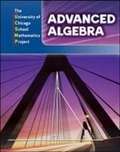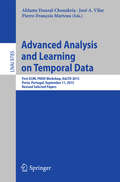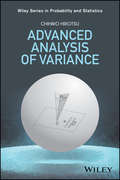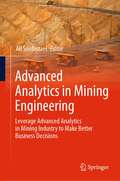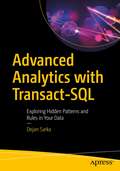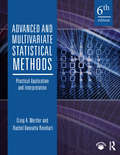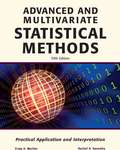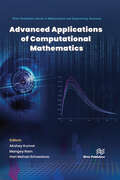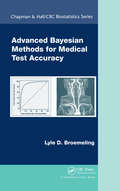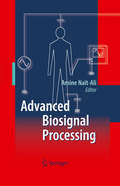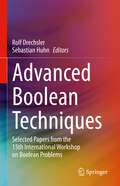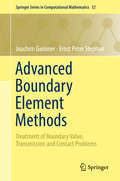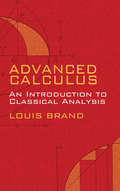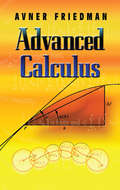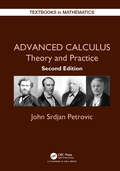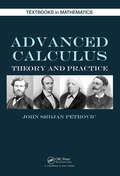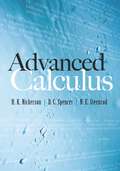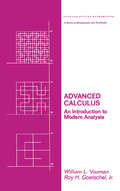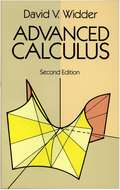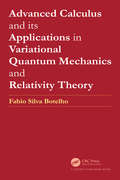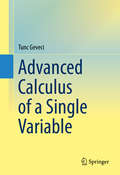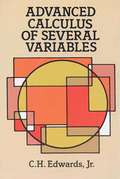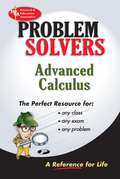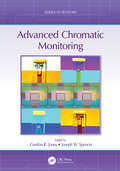- Table View
- List View
Advanced Algebra
by The University of Chicago School Mathematics Project James Flanders Marshall LassakNIMAC-sourced textbook
Advanced Analysis and Learning on Temporal Data: First ECML PKDD Workshop, AALTD 2015, Porto, Portugal, September 11, 2015, Revised Selected Papers (Lecture Notes in Computer Science #9785)
by Ahlame Douzal-Chouakria José A. Vilar Pierre-François MarteauThis book constitutes the refereed proceedings of the First ECML PKDD Workshop, AALTD 2015, held in Porto, Portugal, in September 2016. The 11 full papers presented were carefully reviewed and selected from 22 submissions. The first part focuses on learning new representations and embeddings for time series classification, clustering or for dimensionality reduction. The second part presents approaches on classification and clustering with challenging applications on medicine or earth observation data. These works show different ways to consider temporal dependency in clustering or classification processes. The last part of the book is dedicated to metric learning and time series comparison, it addresses the problem of speeding-up the dynamic time warping or dealing with multi-modal and multi-scale metric learning for time series classification and clustering.
Advanced Analysis of Variance
by Chihiro HirotsuIntroducing a revolutionary new model for the statistical analysis of experimental data In this important book, internationally acclaimed statistician, Chihiro Hirotsu, goes beyond classical analysis of variance (ANOVA) model to offer a unified theory and advanced techniques for the statistical analysis of experimental data. Dr. Hirotsu introduces the groundbreaking concept of advanced analysis of variance (AANOVA) and explains how the AANOVA approach exceeds the limitations of ANOVA methods to allow for global reasoning utilizing special methods of simultaneous inference leading to individual conclusions. Focusing on normal, binomial, and categorical data, Dr. Hirotsu explores ANOVA theory and practice and reviews current developments in the field. He then introduces three new advanced approaches, namely: testing for equivalence and non-inferiority; simultaneous testing for directional (monotonic or restricted) alternatives and change-point hypotheses; and analyses emerging from categorical data. Using real-world examples, he shows how these three recognizable families of problems have important applications in most practical activities involving experimental data in an array of research areas, including bioequivalence, clinical trials, industrial experiments, pharmaco-statistics, and quality control, to name just a few. • Written in an expository style which will encourage readers to explore applications for AANOVA techniques in their own research • Focuses on dealing with real data, providing real-world examples drawn from the fields of statistical quality control, clinical trials, and drug testing • Describes advanced methods developed and refined by the author over the course of his long career as research engineer and statistician • Introduces advanced technologies for AANOVA data analysis that build upon the basic ANOVA principles and practices Introducing a breakthrough approach to statistical analysis which overcomes the limitations of the ANOVA model, Advanced Analysis of Variance is an indispensable resource for researchers and practitioners working in fields within which the statistical analysis of experimental data is a crucial research component. Chihiro Hirotsu is a Senior Researcher at the Collaborative Research Center, Meisei University, and Professor Emeritus at the University of Tokyo. He is a fellow of the American Statistical Association, an elected member of the International Statistical Institute, and he has been awarded the Japan Statistical Society Prize (2005) and the Ouchi Prize (2006). His work has been published in Biometrika, Biometrics, and Computational Statistics & Data Analysis, among other premier research journals.
Advanced Analytics in Mining Engineering: Leverage Advanced Analytics in Mining Industry to Make Better Business Decisions
by Ali SoofastaeiIn this book, Dr. Soofastaei and his colleagues reveal how all mining managers can effectively deploy advanced analytics in their day-to-day operations- one business decision at a time.Most mining companies have a massive amount of data at their disposal. However, they cannot use the stored data in any meaningful way. The powerful new business tool-advanced analytics enables many mining companies to aggressively leverage their data in key business decisions and processes with impressive results.From statistical analysis to machine learning and artificial intelligence, the authors show how many analytical tools can improve decisions about everything in the mine value chain, from exploration to marketing.Combining the science of advanced analytics with the mining industrial business solutions, introduce the “Advanced Analytics in Mining Engineering Book” as a practical road map and tools for unleashing the potential buried in your company’s data.The book is aimed at providing mining executives, managers, and research and development teams with an understanding of the business value and applicability of different analytic approaches and helping data analytics leads by giving them a business framework in which to assess the value, cost, and risk of potential analytical solutions. In addition, the book will provide the next generation of miners – undergraduate and graduate IT and mining engineering students – with an understanding of data analytics applied to the mining industry. By providing a book with chapters structured in line with the mining value chain, we will provide a clear, enterprise-level view of where and how advanced data analytics can best be applied. This book highlights the potential to interconnect activities in the mining enterprise better. Furthermore, the book explores the opportunities for optimization and increased productivity offered by better interoperability along the mining value chain – in line with the emerging vision of creating a digital mine with much-enhanced capabilities for modeling, simulation, and the use of digital twins – in line with leading “digital” industries.
Advanced Analytics with Transact-SQL: Exploring Hidden Patterns and Rules in Your Data
by Dejan SarkaLearn about business intelligence (BI) features in T-SQL and how they can help you with data science and analytics efforts without the need to bring in other languages such as R and Python. This book shows you how to compute statistical measures using your existing skills in T-SQL. You will learn how to calculate descriptive statistics, including centers, spreads, skewness, and kurtosis of distributions. You will also learn to find associations between pairs of variables, including calculating linear regression formulas and confidence levels with definite integration. No analysis is good without data quality. Advanced Analytics with Transact-SQL introduces data quality issues and shows you how to check for completeness and accuracy, and measure improvements in data quality over time. The book also explains how to optimize queries involving temporal data, such as when you search for overlapping intervals. More advanced time-oriented information in the book includes hazard and survival analysis. Forecasting with exponential moving averages and autoregression is covered as well. Every web/retail shop wants to know the products customers tend to buy together. Trying to predict the target discrete or continuous variable with few input variables is important for practically every type of business. This book helps you understand data science and the advanced algorithms use to analyze data, and terms such as data mining, machine learning, and text mining.Key to many of the solutions in this book are T-SQL window functions. Author Dejan Sarka demonstrates efficient statistical queries that are based on window functions and optimized through algorithms built using mathematical knowledge and creativity. The formulas and usage of those statistical procedures are explained so you can understand and modify the techniques presented. T-SQL is supported in SQL Server, Azure SQL Database, and in Azure Synapse Analytics. There are so many BI features in T-SQL that it might become your primary analytic database language. If you want to learn how to get information from your data with the T-SQL language that you already are familiar with, then this is the book for you. What You Will LearnDescribe distribution of variables with statistical measuresFind associations between pairs of variablesEvaluate the quality of the data you are analyzingPerform time-series analysis on your dataForecast values of a continuous variablePerform market-basket analysis to predict customer purchasing patternsPredict target variable outcomes from one or more input variablesCategorize passages of text by extracting and analyzing keywordsWho This Book Is ForDatabase developers and database administrators who want to translate their T-SQL skills into the world of business intelligence (BI) and data science. For readers who want to analyze large amounts of data efficiently by using their existing knowledge of T-SQL and Microsoft’s various database platforms such as SQL Server and Azure SQL Database. Also for readers who want to improve their querying by learning new and original optimization techniques.
Advanced and Multivariate Statistical Methods: Practical Application and Interpretation
by Craig A. Mertler Rachel Vannatta Reinhart* All the statistics traditionally covered in a second-level course are included. * Stresses the conceptual and practical aspects for students who do not need emphasis on the underlying mathematical theory. * Students learn not only the purpose of and how to compute the statistics using SPSS, they also learn the logic behind the techniques and how to test the underlying assumptions. * Students are shown how to interpret, present, and write up the results for each technique. * Exercises allow students to practice their newly acquired skills. The answer key will be provided with professors' copies. * If your students are overwhelmed by advanced statistics texts that are too technical and mathematical, you should examine this highly applied approach to multivariate statistics. Covers why, what, when and how. Ideal for nonmath majors. * The numerous screenshots and examples of output make it easy for students to follow the text. * Each statistical method is followed by an explanation of why a student might use that method, including a discussion of its purpose and sample research questions it can address. * The authors also show a sample study with an example of how to write up the results. Students see firsthand how to present their statistical findings. * Although SPSS is the program that is illustrated, students using any program will benefit greatly from the conceptual material.
Advanced and Multivariate Statistical Methods: Practical Application and Interpretation Fifth Edition
by Craig A. Mertler Rachel A. Vannatta* All the statistics traditionally covered in a second-level course are included. * Stresses the conceptual and practical aspects for students who do not need emphasis on the underlying mathematical theory. * Students learn not only the purpose of and how to compute the statistics using SPSS, they also learn the logic behind the techniques and how to test the underlying assumptions. * Students are shown how to interpret, present, and write up the results for each technique. * Exercises allow students to practice their newly acquired skills. The answer key will be provided with professors' copies. * If your students are overwhelmed by advanced statistics texts that are too technical and mathematical, you should examine this highly applied approach to multivariate statistics. Covers why, what, when and how. Ideal for nonmath majors. * The numerous screenshots and examples of output make it easy for students to follow the text. * Each statistical method is followed by an explanation of why a student might use that method, including a discussion of its purpose and sample research questions it can address. * The authors also show a sample study with an example of how to write up the results. Students see firsthand how to present their statistical findings. * Although SPSS is the program that is illustrated, students using any program will benefit greatly from the conceptual material.
Advanced Applications of Computational Mathematics: Theoretical Advances And Advanced Applications (De Gruyter Series On The Applications Of Mathematics In Engineering And Information Sciences Ser. #3)
by Akshay Kumar Mangey Ram Hari Mohan SrivastavaThis book “Advanced Applications of Computational Mathematics” covers multidisciplinary studies containing advanced research in the field of computational and applied mathematics. The book includes research methodology, techniques, applications, and algorithms. The book will be very useful to advanced students, researchers and practitioners who are involved in the areas of computational and applied mathematics and engineering.
Advanced Bayesian Methods for Medical Test Accuracy (Chapman & Hall/CRC Biostatistics Series)
by Lyle D. BroemelingUseful in many areas of medicine and biology, Bayesian methods are particularly attractive tools for the design of clinical trials and diagnostic tests, which are based on established information, usually from related previous studies. Advanced Bayesian Methods for Medical Test Accuracy begins with a review of the usual measures such as specificity
Advanced Biosignal Processing
by Amine Nait-AliThrough 17 chapters, this book presents the principle of many advanced biosignal processing techniques. After an important chapter introducing the main biosignal properties as well as the most recent acquisition techniques, it highlights five specific parts which build the body of this book. Each part concerns one of the most intensively used biosignals in the clinical routine, namely the Electrocardiogram (ECG), the Elektroenzephalogram (EEG), the Electromyogram (EMG) and the Evoked Potential (EP). In addition, each part gathers a certain number of chapters related to analysis, detection, classification, source separation and feature extraction. These aspects are explored by means of various advanced signal processing approaches, namely wavelets, Empirical Modal Decomposition, Neural networks, Markov models, Metaheuristics as well as hybrid approaches including wavelet networks, and neuro-fuzzy networks. The last part, concerns the Multimodal Biosignal processing, in which we present two different chapters related to the biomedical compression and the data fusion. Instead organising the chapters by approaches, the present book has been voluntarily structured according to signal categories (ECG, EEG, EMG, EP). This helps the reader, interested in a specific field, to assimilate easily the techniques dedicated to a given class of biosignals. Furthermore, most of signals used for illustration purpose in this book can be downloaded from the Medical Database for the Evaluation of Image and Signal Processing Algorithm. These materials assist considerably the user in evaluating the performances of their developed algorithms. This book is suited for final year graduate students, engineers and researchers in biomedical engineering and practicing engineers in biomedical science and medical physics.
Advanced Boolean Techniques: Selected Papers from the 15th International Workshop on Boolean Problems
by Rolf Drechsler Sebastian HuhnThis book describes recent findings in the domain of Boolean logic and Boolean algebra, covering application domains in circuit and system design, but also basic research in mathematics and theoretical computer science. Content includes invited chapters and a selection of the best papers presented at the 15th annual International Workshop on Boolean Problems.
Advanced Boundary Element Methods: Treatment of Boundary Value, Transmission and Contact Problems (Springer Series in Computational Mathematics #52)
by Ernst Peter Stephan Joachim GwinnerThis book is devoted to the mathematical analysis of the numerical solution of boundary integral equations treating boundary value, transmission and contact problems arising in elasticity, acoustic and electromagnetic scattering. It serves as the mathematical foundation of the boundary element methods (BEM) both for static and dynamic problems. The book presents a systematic approach to the variational methods for boundary integral equations including the treatment with variational inequalities for contact problems. It also features adaptive BEM, hp-version BEM, coupling of finite and boundary element methods – efficient computational tools that have become extremely popular in applications.Familiarizing readers with tools like Mellin transformation and pseudodifferential operators as well as convex and nonsmooth analysis for variational inequalities, it concisely presents efficient, state-of-the-art boundary element approximations and points to up-to-date research.The authors are well known for their fundamental work on boundary elements and related topics, and this book is a major contribution to the modern theory of the BEM (especially for error controlled adaptive methods and for unilateral contact and dynamic problems) and is a valuable resource for applied mathematicians, engineers, scientists and graduate students.
Advanced Calculus: An Introduction to Classical Analysis
by Louis BrandA course in analysis that focuses on the functions of a real variable, this text is geared toward upper-level undergraduate students. It introduces the basic concepts in their simplest setting and illustrates its teachings with numerous examples, practical theorems, and coherent proofs.Starting with the structure of the system of real and complex numbers, the text deals at length with the convergence of sequences and series and explores the functions of a real variable and of several variables. Subsequent chapters offer a brief and self-contained introduction to vectors that covers important aspects, including gradients, divergence, and rotation. An entire chapter is devoted to the reversal of order in limiting processes, and the treatment concludes with an examination of Fourier series.
Advanced Calculus (Dover Books on Mathematics)
by Prof. Avner FriedmanThis rigorous two-part treatment advances from functions of one variable to those of several variables. Intended for students who have already completed a one-year course in elementary calculus, it defers the introduction of functions of several variables for as long as possible, and adds clarity and simplicity by avoiding a mixture of heuristic and rigorous arguments.The first part explores functions of one variable, including numbers and sequences, continuous functions, differentiable functions, integration, and sequences and series of functions. The second part examines functions of several variables: the space of several variables and continuous functions, differentiation, multiple integrals, and line and surface integrals, concluding with a selection of related topics. Complete solutions to the problems appear at the end of the text.
Advanced Calculus: Theory and Practice (Textbooks in Mathematics #12)
by John PetrovicAdvanced Calculus: Theory and Practice, Second Edition offers a text for a one- or two-semester course on advanced calculus or analysis. The text improves students’ problem-solving and proof-writing skills, familiarizes them with the historical development of calculus concepts, and helps them understand the connections among different topics. The book explains how various topics in calculus may seem unrelated but have common roots. Emphasizing historical perspectives, the text gives students a glimpse into the development of calculus and its ideas from the age of Newton and Leibniz to the twentieth century. Nearly 300 examples lead to important theorems.Features of the Second Edition: Improved Organization. Chapters are reorganized to address common preferences. Enhanced Coverage of Axiomatic Systems. A section is added to include Peano’s system of axioms for the set of natural numbers and their use in developing the well-known properties of the set N. Expanded and Organized Exercise Collection. There are close to 1,000 new exercises, many of them with solutions or hints. Exercises are classified based on the level of difficulty. Computation-oriented exercises are paired and solutions or hints provided for the odd-numbered questions. Enrichment Material. Historical facts and biographies of over 60 mathematicians. Illustrations. Thirty-five new illustrations are added in order to guide students through examples or proofs. About the Author:John Srdjan Petrovic is a professor at Western Michigan University.
Advanced Calculus: Theory and Practice (Textbooks in Mathematics)
by John PetrovicSuitable for a one- or two-semester course, Advanced Calculus: Theory and Practice expands on the material covered in elementary calculus and presents this material in a rigorous manner. The text improves students' problem-solving and proof-writing skills, familiarizes them with the historical development of calculus concepts, and helps them unders
Advanced Calculus
by D. C. Spencer H. K Nickerson N. E. SteenrodClassroom-tested in a Princeton University honors course, it offers students a unified introduction to advanced calculus. Starting with an abstract treatment of vector spaces and linear transforms, the authors introduce a single basic derivative in an invariant form. All other derivatives — gradient, divergent, curl, and exterior — are obtained from it by specialization. The corresponding theory of integration is likewise unified, and the various multiple integral theorems of advanced calculus appear as special cases of a general Stokes formula. The text concludes by applying these concepts to analytic functions of complex variables.
Advanced Calculus: An Introduction to Modern Analysis (Pure and Applied Mathematics #63)
by William L. VoxmanAdvanced Calculus: An Introduction to Modem Analysis, an advanced undergraduate textbook,provides mathematics majors, as well as students who need mathematics in their field of study,with an introduction to the theory and applications of elementary analysis. The text presents, in an accessible form, a carefully maintained balance between abstract concepts and applied results of significance that serves to bridge the gap between the two- or three-semester calculus sequence and senior/graduate level courses in the theory and applications of ordinary and partial differential equations, complex variables, numerical methods, and measure and integration theory.The book focuses on topological concepts, such as compactness, connectedness, and metric spaces,and topics from analysis including Fourier series, numerical analysis, complex integration, generalized functions, and Fourier and Laplace transforms. Applications from genetics, spring systems,enzyme transfer, and a thorough introduction to the classical vibrating string, heat transfer, and brachistochrone problems illustrate this book's usefulness to the non-mathematics major. Extensive problem sets found throughout the book test the student's understanding of the topics and help develop the student's ability to handle more abstract mathematical ideas.Advanced Calculus: An Introduction to Modem Analysis is intended for junior- and senior-level undergraduate students in mathematics, biology, engineering, physics, and other related disciplines.An excellent textbook for a one-year course in advanced calculus, the methods employed in this text will increase students' mathematical maturity and prepare them solidly for senior/graduate level topics. The wealth of materials in the text allows the instructor to select topics that are of special interest to the student.
Advanced Calculus: Second Edition
by David V. WidderThis classic text by a distinguished mathematician and former Professor of Mathematics at Harvard University, leads students familiar with elementary calculus into confronting and solving more theoretical problems of advanced calculus. In his preface to the first edition, Professor Widder also recommends various ways the book may be used as a text in both applied mathematics and engineering.Believing that clarity of exposition depends largely on precision of statement, the author has taken pains to state exactly what is to be proved in every case. Each section consists of definitions, theorems, proofs, examples and exercises. An effort has been made to make the statement of each theorem so concise that the student can see at a glance the essential hypotheses and conclusions.For this second edition, the author has improved the treatment of Stieltjes integrals to make it more useful to the reader less than familiar with the basic facts about theRiemann integral. In addition the material on series has been augmented by the inclusion of the method of partial summation of the Schwarz-Holder inequalities, and of additional results about power series. Carefully selected exercises, graded in difficulty, are found in abundance throughout the book; answers to many of them are contained in a final section.
Advanced Calculus and its Applications in Variational Quantum Mechanics and Relativity Theory
by Fabio Silva BotelhoThe first part of this book reviews some key topics on multi-variable advanced calculus. The approach presented includes detailed and rigorous studies on surfaces in Rn which comprises items such as differential forms and an abstract version of the Stokes Theorem in Rn. The conclusion section introduces readers to Riemannian geometry, which is used in the subsequent chapters. The second part reviews applications, specifically in variational quantum mechanics and relativity theory. Topics such as a variational formulation for the relativistic Klein-Gordon equation, the derivation of a variational formulation for relativistic mechanics firstly through (semi)-Riemannian geometry are covered. The second part has a more general context. It includes fundamentals of differential geometry. The later chapters describe a new interpretation for the Bohr atomic model through a semi-classical approach. The book concludes with a classical description of the radiating cavity model in quantum mechanics.
Advanced Calculus of a Single Variable
by Tunc GeveciThis advanced undergraduate textbook is based on a one-semester course on single variable calculus that the author has been teaching at San Diego State University for many years. The aim of this classroom-tested book is to deliver a rigorous discussion of the concepts and theorems that are dealt with informally in the first two semesters of a beginning calculus course. As such, students are expected to gain a deeper understanding of the fundamental concepts of calculus, such as limits (with an emphasis on ε-δ definitions), continuity (including an appreciation of the difference between mere pointwise and uniform continuity), the derivative (with rigorous proofs of various versions of L'Hôpital's rule) and the Riemann integral (discussing improper integrals in-depth, including the comparison and Dirichlet tests). Success in this course is expected to prepare students for more advanced courses in real and complex analysis and this book will help to accomplish this. The first semester of advanced calculus can be followed by a rigorous course in multivariable calculus and an introductory real analysis course that treats the Lebesgue integral and metric spaces, with special emphasis on Banach and Hilbert spaces.
Advanced Calculus of Several Variables (Dover Books on Mathematics)
by C. H. Edwards Jr.Modern conceptual treatment of multivariable calculus, emphasizing interplay of geometry and analysis via linear algebra and the approximation of nonlinear mappings by linear ones. Over 400 well-chosen problems. 1973 edition.
Advanced Calculus Problem Solver
by Editors of REAREA's Advanced Calculus Problem Solver Each Problem Solver is an insightful and essential study and solution guide chock-full of clear, concise problem-solving gems. Answers to all of your questions can be found in one convenient source from one of the most trusted names in reference solution guides. More useful, more practical, and more informative, these study aids are the best review books and textbook companions available. They're perfect for undergraduate and graduate studies. This highly useful reference is the finest overview of advanced calculus currently available, with hundreds of calculus problems that cover everything from point set theory and vector spaces to theories of differentiation and integrals. Each problem is clearly solved with step-by-step detailed solutions.
Advanced Chromatic Monitoring (Series in Sensors)
by Gordon R. Jones and Joseph W. SpencerAdvanced Chromatic Monitoring provides a major source of information about the novel approach of chromaticity with examples of how chromaticity may be deployed for various monitoring applications. It shows with examples what can be achieved with chromatic methods in producing relevant information with a variety of test techniques and in facilitating the interpretation of complex data about complicated situations. It will be of interest to postgraduates and researchers in a wide breadth of physical disciplines (engineering, medicine, environmental sciences) and those involved with data acquisition and analysis. Key Features: Applicable to a wide range of disciplines (engineering, medical, environmental, etc) and those interested in science, technology, data acquisition and analysis Provides an extrapolation of new knowledge well beyond that covered in existing literature with regard to dealing with complicated forms and sets of data Addresses inspiring and innovative areas of research including environmental, power delivery and medical monitoring About the Editors: Emeritus Professor Gordon R. Jones – founder and former Director of the Centre for Intelligent Monitoring Systems (CIMS), former Head of the Department of Electrical Engineering and Electronics, and former Director of Electric Arcs Research Group at the University of Liverpool. He was awarded the IEEE Education, Science and Technology Achievement Medal (1999). Professor Joe W. Spencer – the present Director of CIMS at the University of Liverpool, having been Head of the Department of Electrical Engineering and Electronics at Liverpool. He is involved in operating a multi-million pound technology transfer unit (Sensor City, Liverpool) with whose establishment he played a major role and with which CIMS has major interactions.
